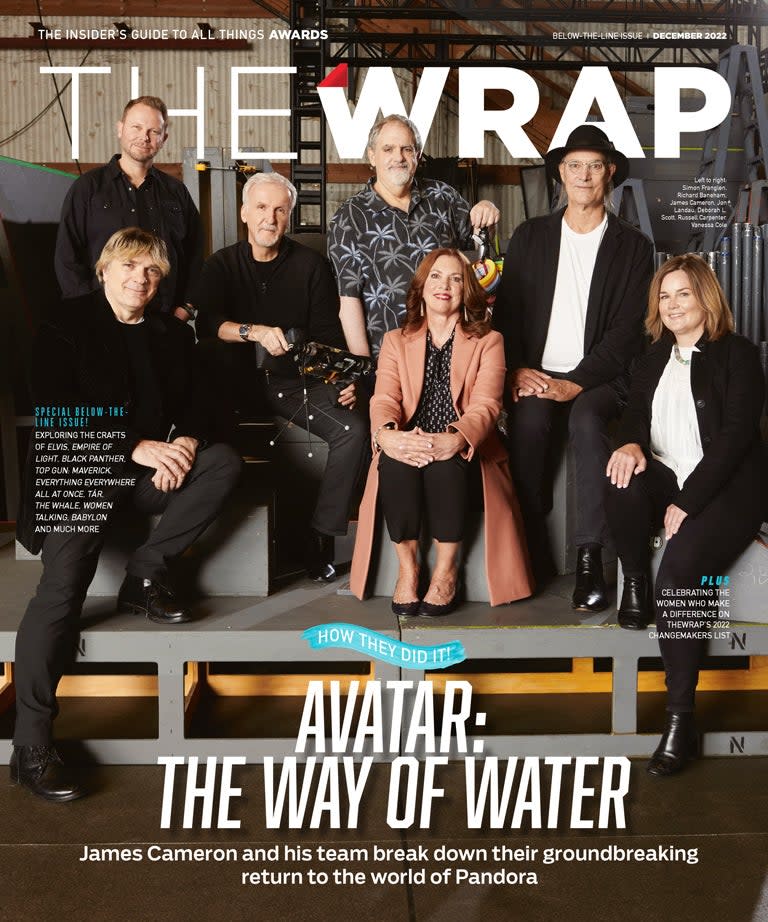How the Designers of ‘Elvis’ and ‘Blonde’ Brought 2 Icons Back to Life on Screen
- Oops!Something went wrong.Please try again later.
- Oops!Something went wrong.Please try again later.
- Oops!Something went wrong.Please try again later.
This story about the design of “Elvis” and “Blonde” first appeared in the Below-the-Line Issue of TheWrap’s awards magazine.
You couldn’t find two more iconic pop-culture figures from the 20th century than Elvis Presley and Marilyn Monroe – or, perhaps, two more daunting people to re-create on screen the way they are re-created in Baz Luhrmann’s “Elvis” and Andrew Dominick’s “Blonde.” In both films, the production and costume designers and the makeup and hairstyling artists were asked to duplicate some of the most familiar looks of the era – and, at times to subtly tweak those looks.
TheWrap talked to the below-the-line talent responsible for the uncanny looks of both films.
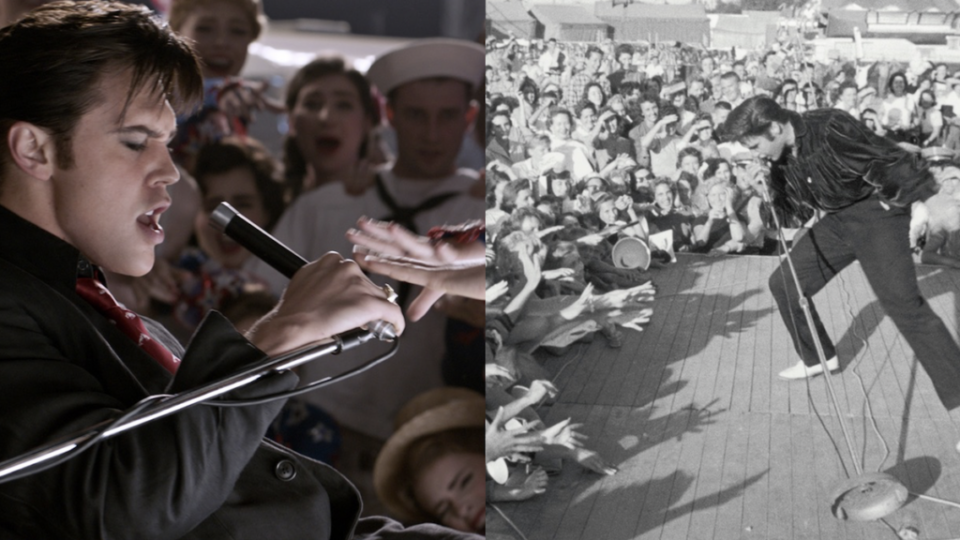
“Elvis”
Designing the world and the clothes of Elvis Presley in Baz Luhrmann’s extravagant biopic-fantasia “Elvis” initially seemed pretty straightforward to Catherine Martin, Luhrmann’s costume designer, production designer, executive producer and wife. After all, Elvis’ life, career and sartorial choices were thoroughly documented, from the young, feral Elvis, tapping into a power he could scarcely explain in pink shirts (pink, for a truck driver!) to the “Jailhouse Rock” Elvis, the silly-movie Elvis, the black-leather comeback Elvis and the spangled jumpsuit Vegas Elvis.
“I thought, ‘Oh, this is gonna be amazing, because I’m going to get to flex a different muscle,” Martin said. “This is going to be incredibly detailed research and then technical execution. But I kind of underestimated the scale and the sheer volume of possibilities.”
Martin did enough research to know exactly what Elvis wore in key moments of his life, but duplicating an outfit wouldn’t necessarily convey to a modern audience just how shocking Elvis was at that moment in time. “What I enjoy about design is that it’s problem solving,” she said. “How do we make Elvis’ clothes connect with modern audiences while still being historically accurate?
“That involves an archaeological dig of finding all the idiosyncratic things that were specifically Elvis in the ’50s but were edgy enough to shock and surprise people today — things that still had currency today in terms of challenging gender norms.”
For early Elvis, she focused not only on the colors, but on details like the way Elvis sometimes tied his shirts above his high-waisted pants. “It was also making sure that the clothes connected to the sensuality and sexuality of his body movement, which Austin (Butler) channeled.”
For the 1968 “comeback” special, for instance, she made several different versions of Elvis’ iconic black-leather suit — one that looked great when Butler walked down the hall, one that was good for sitting, one for dancing.
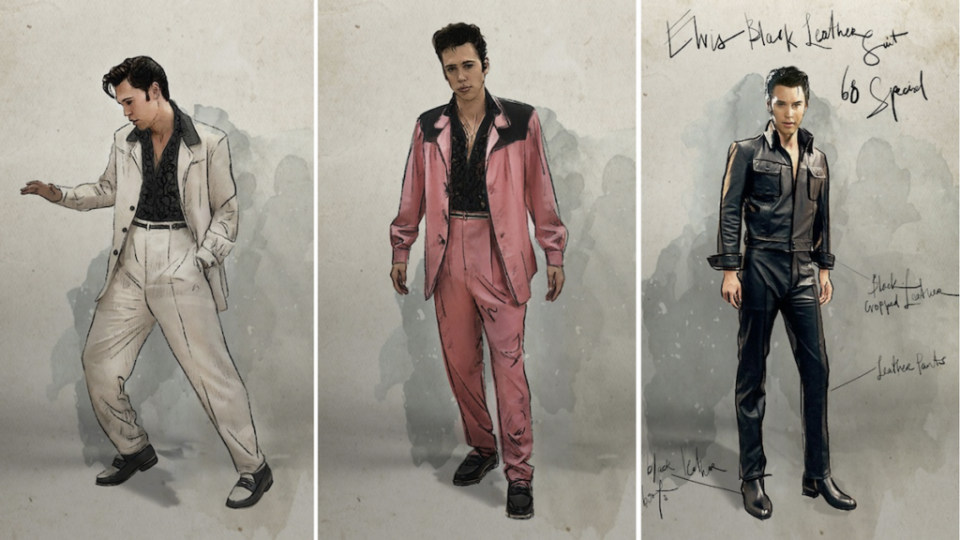
She also compiled an enormous chart of every jumpsuit Elvis wore during his years in Las Vegas and on the road, though she didn’t always stick with the most historically accurate ones.
“We had the perfect chronology on the wall, but we made story choices,” she said. “His opening night in Vegas (in 1969), he actually wore a black karate outfit, but we wanted to put him in something that was the purest form of Elvis in a white jumpsuit. We really leaned into the white suits when he was white-hot and godlike in his performance skills. And as things got crazier, we started to go into color and more crazily embroidered and decorated suits. And then the last suit we see goes back to white.”
Also Read:
Here Are All the Songs in ‘Elvis’: Listen to the Soundtrack
The Vegas years also presented some of the biggest challenges for the production design done by Martin and fellow production designer Karen Murphy. “The showroom of the International Hotel was a challenge because of the sheer size of it,” Murphy said. “At the time it had the biggest curtain in North America, and we thought we just couldn’t build something that big. But we created it.”
There was less documentation, though, of the hotel rooms where Elvis lived while in Vegas. “There were some photographs from when celebrities came to see him,” Murphy said. “You’d see the corner of the room, and we’d try to piece together those photographs. But we could never really work out what the bedroom looked like, so it became more like, ‘How does it need to feel?’ Baz said he wanted a gilded sarcophagus where Elvis was trapped, so that was where the design came from.”
The entire film was shot in Australia, from the muddy streets of Tupelo to the carnival where Colonel Parker (Tom Hanks) worked to the frenzied nightlife of Memphis’ Beale Street. They shot scenes from the ’68 special, which was taped on a soundstage in Burbank, on a soundstage in Queensland, and things got “very meta,” according to Murphy.
And then there was Graceland, Elvis’ longtime home. Luhrmann and Martin were able to tour the property with the blessings of the Presley estate, which also gave them plenty of measurements so they could duplicate the dimensions of the original.
“We built Graceland as a replica absolutely to the centimeter,” Martin said. “It’s a lovely house, it’s a mansion, but it’s not what we know as a mansion today, which is just completely outscale. So people would walk on the set and go, ‘Oh, this feels small.’ And we’d go, ‘Well, this is exactly what Graceland was.’”
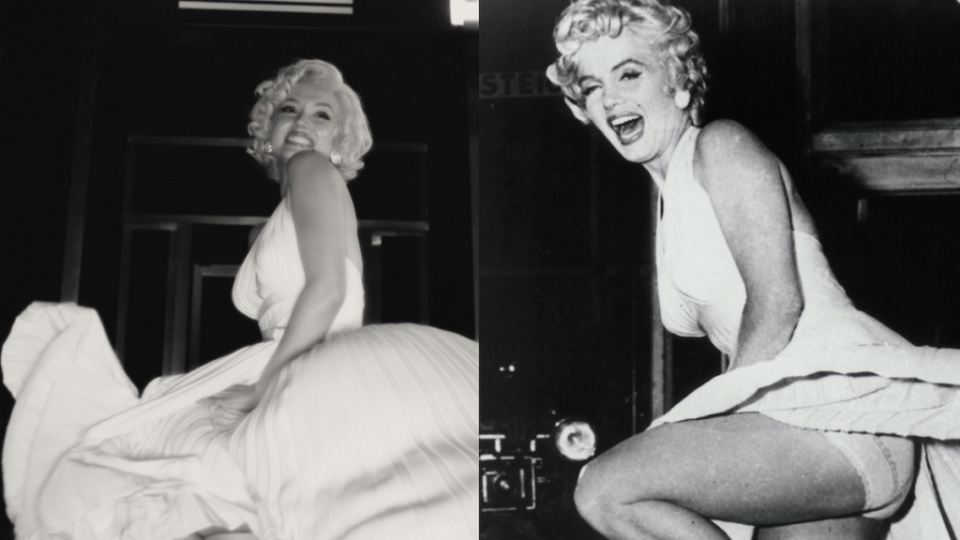
“Blonde”
In Andrew Dominik’s “Blonde,” Ana de Armas does not play Marilyn Monroe. The movie, after all, is based on Joyce Carol Oates’ 2000 novel of the same name, which Oates always insisted was a fiction inspired by Monroe rather than a biography of the actress. It’s a fantasia on Marilyn’s life and the demons the actress may have faced, a riff on the idea of Marilyn Monroe.
But for the “Blonde” makeup artists and hairstylists, costume designer and production designer, the fictional aspect of the film was essentially irrelevant. Their task was to duplicate the Marilyn Monroe who existed in the hundreds of photos that lined the walls of the production office and filled the 800-page PDF that director Dominik had assembled (“The Bible,” they called it), and who lived in the film clips that Dominik played on monitors side-by-side with his film’s re-creations of those moments.
“We kind of had to forget about the fictionalized part, because Andrew had given us so many specific images that we needed to get as close as possible,” hair department head Jaime Leigh McIntosh said. Makeup department head Tina Roesler Kerwin added, “The story is fictional, but the image that he’s using to tell the story is very much Marilyn.”
Also Read:
‘Blonde’ Director Explains the Netflix Film’s Ending: ‘It Was Just What I Believed’
For McIntosh and Roesler Kerwin, the challenges began with de Armas’ hair, which is naturally far darker than Monroe’s. “The first time Ana camera-tested, they put her in a blonde wig and you could very clearly see her dark hair through that,” McIntosh said.
Roesler Kerwin came up with prosthetic pieces that would look like scalp through the wig and would allow McIntosh to re-create Marilyn’s hairline accurately. “Those prosthetic pieces also gave us the ability to change the wigs multiple times during the day, which we couldn’t have done with a bald cap because it wouldn’t have held up to the gluing and wiggling,” she said. De Armas’ eyebrows were also lightened and thinned to match Marilyn’s.
From there it wasn’t as simple as using Monroe’s makeup on de Armas, because the two women’s faces and skin were different. “Andrew told me to find Marilyn within Ana,” Roesler Kerwin said. In most cases that meant finding the Marilyn from one of the images in Dominik’s “Bible.” “About 80% of the time, we were matching some kind of imagery that Andrew had,” McIntosh said.
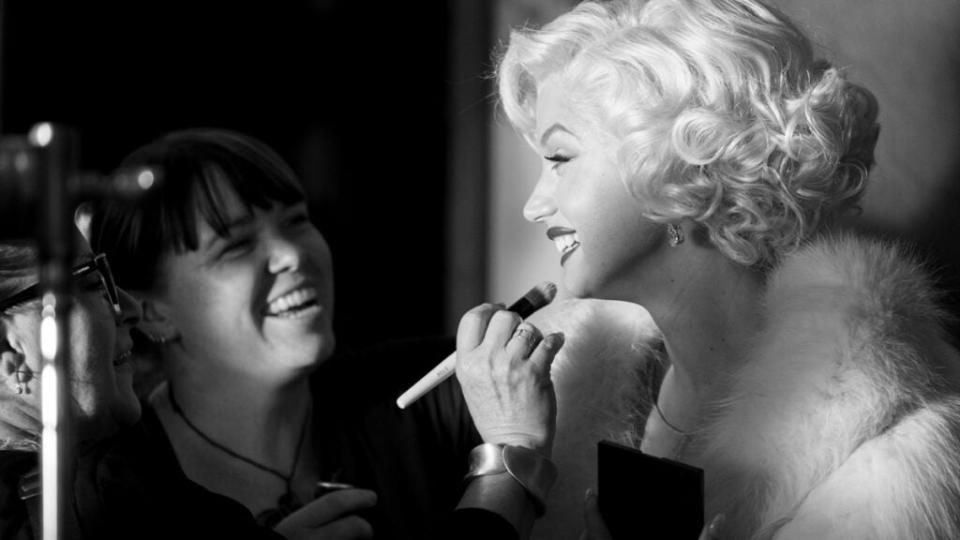
Costume designer Jennifer Johnson also had to do a lot of matching from that book, including re-creating some of the most famous dresses ever, among them the slinky red gown from “Gentlemen Prefer Blondes” and the white dress from “The Seven Year Itch.”
“That was a little terrifying,” Johnson said, referring to the latter dress. “We all know it so well, and I didn’t want it to feel like a Halloween costume. I ended up adding a little more fabric to the circumference of the skirt, because I knew that there’d be this very luxurious slow-motion scene where the audience would really be able to take in the weight and the monumental importance of Marilyn.”
Also Read:
‘Blonde’ Cast and Character Guide: Who Plays Who in the Marilyn Monroe Film? (Photos)
She did make some changes to Marilyn’s look, reducing the pointiness of de Armas’ bras so they didn’t look “comical and distracting” and choosing not to add prosthetics to give the actress more pronounced curves. “There was not much done to change her actual shape, other than building her bust out and cinching her waist in,” she said.
(She did, however, build some padding into one dress reproducing a “Some Like It Hot” look.)
Some of “Blonde” was shot in black-and-white, which meant that Johnson and production designer Florencia Martin needed to be aware of how colors photograph.
“Black-and-white can be extremely tricky,” Johnson said. “In some cases I had a few backup colors, because colors can become very muddy and bland. I had a very strict palette, and the iPhone black-and-white filter is your best friend when you’re shooting black-and-white.”
Martin said she too used that technique to figure out how sets would photograph in monochrome. “Reds turn black and wood grains can do really strange things,” she said. “It’s a fun challenge, and we were constantly using the filters on our phones.”
The production designer was able to shoot in a couple of the real locations from Marilyn’s life, from the bungalow where she and her mother first lived in Hollywood to the Brentwood home where she died. She even had the receipts from the shopping Marilyn did at a Mexican furniture store to outfit that latter house, which allowed her to reproduce the interior accurately.
“It was really important to Andrew to go into the locations where Marilyn lived,” Martin said. “It was amazing to navigate through Los Angeles and stitch her life back together. And we were able to build in all these different textures and elements to take the viewers through these chapters of her life.”
In addition to Marilyn’s homes, though, she had to re-create iconic scenes from her movies as accurately as possible, with limited time and budget. “All the studio sets were built on one soundstage, and we shot them all in three or four days,” she said. “So what my team did was build the back of the sets to look like they’d been built in the ’50s, so we could turn the walls and use them as the backstage world of that scene. “Marilyn might be on the ‘Some Like It Hot’ set, and the audience doesn’t know it but they’re looking at the back of ‘All About Eve.’ There’s something poetic about creating that kind of collage of her life.”
Read more from the Below-the-Line issue here.
